CD – 7 tracks – 48 minutes
Using location recordings, weather, birdsong and radio, BJNilsen continues to map and explore uncharted territory.
A follower to 2005’s Fade to White [Touch # TO:65], BJNilsen develops his work further, based on field recordings and electronics. This time he adds harsher yet clearer harmonies with musical elements to the compositions, creating a beautifully complex and detailed study. Recorded in 2006-7 with mostly analogue equipment, using up to 50 year-old tapemachines, filters and generators that end up being the soft cushion in these cold location recordings.
Location recordings from Mälaren, Stockholm, Sweden; Coombe Gibbet, Berkshire, England and Landakot, Vatnsleysuströnd, Iceland.
Telefunken M10 and M5, Studer B67, Ferrograph Series 4, Bruel and Kjær Sine-Random Generator and Frequency Analyzers. Also Monowave, Sequential Circuits ProOne, Korg MS20, Esq1, MOTU 828MK2, Ableton Live, Logic Audio 6
Morin khuur on Black Light played by Hildur Ingveldardóttir Gudnadóttir
Track list:
1. Front
2. Finisterre
3. Pole of Inaccessibility
4. Viking, Cromarty…
5. Black Light
6. Icing Station
7. Viking North
Reviews:
The Silent Ballet (net):
BJ Nilsen’s last solo album, Fade to White, was my favorite album of 2005, so I approached the release of The Short Night with equal parts trepidation and anticipation. In the interim, Nilsen had committed to disk two vodka-drenched drone recordings with Stilluppsteypa, a quiet cello collaboration (Second Childhood) with Hildur Gudnadottir and a processed field-recording statement (Storm) with Chris Watson. How would these collaborations influence his solo work? I wondered. Would they enhance his creativity, or detract from it?
The answer is mixed, because The Short Night seems much less a follow-up to Fade to White than it does a development of themes explored on Storm.The Short Night is a dark album, at times even oppressive, marked by claustrophobic tones rather than liberating twinkles. “Front” begins with a whoosh, described by Nilsen as “an upset crow, thrown by a gust of wind onto the rainy south coast of Iceland.” We hear the rain, wind, and “unidentified birds.” Then the high-frequency tones enter, and are eventually joined by other washes of circuitry, performing an uncanny simulation of bells and boards. The middle section of this 14-minute track is a bit underdeveloped, and could have used a bit of editing, but the end is nice, with the rain returning in short bursts as the electronic undulations disappear.
The rain continues in “Finisterne,” reverberating as if falling in prayer bowls. “Finisterne” feels like the fog of late autumn: bitter, but not cold enough for snow. Somber tones rise from the background, creating a Murcof-like sense of menace, but without the strings. At the 5½ minute mark, a static melody arrives like rolling swells, gradually increasing in volume, adding flotsam and jetsam along the way, but never quite crashing along the shore. This proves to be the perfect setup for “Pole of Inaccessibility,” which begins with a two-minute crumple of electric debris, then flattens into a lonely sequence of analogues. You’ll have to like birds to enjoy this track, because a small flock inhabits its alcoves.
Downloaders be warned: the 6-second “Viking, Cromarty” is merely a weather report, and is probably not worth the 99 cents. Skip instead to “Black Light,” the album’s first track with a tempo, augmented by what sounds like wind passing through fluted caves. Bold, authoritative notes are struck early, leading us to expect something greater; but after only two major chords, the track ends at the four-minute mark, leaving us feeling a bit robbed. The two-minute “Icing Station” (Track 6) is woefully misplaced; we’re still getting over our shock, and this song is a throwback to the earlier tracks. Oddly enough, it slots perfectly between Tracks 2 and 3 (Kids, do try this at home).
Fortunately, the album’s 10-minute closing track, “Viking North,” is a slow, birdless builder, evoking the best of Belong. While it never reaches the EQ levels of “Nine Ways till Sunday” (Fade to White’s closer), such heights would be sonically out of place in this setting. Instead, the track slowly rises in complexity and volume, then ebbs on a gentle electronic cushion, allowing the digitally-looped weather report to return; and this time, it sounds just right. This is the track that should have followed “Black Light,” because its extended climax makes up for the former’s premature climax and makes “Black Light” seem more like foreshadowing than disappointment.
Following a masterpiece is always a challenge. Many artists never rise to the occasion, and try with increasing desperation to repeat their former glories. At first, I thought that I wanted another album just like Fade to White, but in retrospect I’m glad to see Nilsen stretching his boundaries, content neither to rest on past successes nor to fade away. As the artist formerly known as Morthund and as Hazard, he’s been reinventing himself for years. The unprocessed field recordings are a great touch; in the future, I’d love to see another collaboration with Watson, perhaps a conceptual album encompassing the four seasons. But what’s great about Nilsen is that no matter how much or how long, he records, I’m never quite sure what to expect from him next, which is why I’m just as excited about his next album as I was for this one. [Richard Allen]
Blog (UK):
Gradually I’m catching up on some of the releases from last year that were high on my “to hear” list. The Short Night came out last September and is one of those CDs that has built up a strong reputation largely through good old fashioned word of mouth recommendations. Monorail in Glasgow say that they are shifting copies at twice the rate now than they were when it was released.
The Short Night takes field recordings from southern England, Sweden, Iceland and Italy and weaves them into a web of electronic drones and ambient washes. In some ways it feels like a nautical equivalent of the astronomical journeys of Murcof’s Cosmos. “Front” is a long, relatively static opener that serenely glides along with little in the way of changes. “Finisterre” starts in a similar vein, but with a much darker hue. The lapping water and singing gulls give way to an almost metallic drone, before a warmer, rolling wash of sound envelops the track with a subtle, slightly glitchy melancholy that builds into a stormy crescendo.
“Pole Of Inaccessibility” hums with sub-bass drones, and high end crackle, but has a calm centre and ends with the twitter of birds and a six second snatch of the Shipping Forecast (“Viking, Cromarty…”). “The Black Light” has an air of menace that ends in a short shard of white noise, whereas “Icing Station” takes the levels down again. The album ends with its best track, “Viking North”, a penetrating drone piece that threatens to turn the speakers into piles of smouldering ash before relenting and fading into another, slightly warped, rendition of the Shipping Forecast.
The Short Night falls into an area of experimental electronic music somewhere between Murcof, Stars Of The Lid, Biosphere and Pan Sonic. What it lacks in obvious melody, it more than makes up for in mood and atmosphere. Even at its most serene, there is an air of threat, and yet at its most threatening there is also a calm constancy at the centre. Like the aforementioned artists, Nilsen is pushing music into areas where environmental and generated sounds are becoming indistinguishable. A kind of back-to-nature, earth science electronica if that makes any sense.
Boomkat (UK):
Touch are a label that always put quality control above all else. They don’t release much, but you can guarantee that when they do release something it’s of an almost untouchable standard, and their small but perfectly formed group of artists are a testament to that. They first welcomed Swedish experimental artist BJ Nilsen into the fold in the late 90s, when he was writing under the name Hazard, but since then Nilsen has developed and ‘The Short Night’, his latest full length record, is for me his most coherent and enjoyable album to date. Nilsen has been busy in the last few years, contributing to the incredible ‘Storm’ album with field recording veteran Chris Watson and also to ‘Second Childhood’ with cellist Hildur Gudnadóttir and Icelandic trio Stilluppsteypa but ‘The Short Night’ feels like the masterwork these records were building up to. Utilising his tuned ear for field recording, Nilsen blends environmental sounds collected in Sweden, Iceland and England and layers them above and beneath some quite stunninelectronic parts. Taking vintage equipment (Sequential Circuits Pro-One, old Scandinavian generators, Korg MS20 etc) and recording and mixing using modern computer technology he comes up with a sound that owes as much to early innovators Popol Vuh and Delia Derbyshire as it does more recent ambient-darlings Biosphere and Deathprod. The mood is one of grim, crust-laden darkness, something akin to being trapped in an abandoned building as the Phantom of the Opera plays mercilessly in a sewer below – but while the mood is shadowy the sounds never become oppressive. Maybe it’s due to the hypnotic nature of the compositions that draw you in and take hold of you entirely or possibly the actual character of the vintage generators used but the sounds float in and out of your consciousness with a wool-lined ease. Even as the album draws to a tremulous close with the incredible organ-drenched ‘Viking North’ and the amps reach eleven it is still washed with a veneer of melancholy and a palatable sheen that takes it above and beyond so many albums lumped into the same category. Touch have done it again then and thrown out yet another high water mark for the genre and a shining beacon in a mire of mediocrity. Huge recommendation.
Brainwashed (USA):
Those recordings that can successfully create visual atmosphere as well as an audio one are rare, but here is one that conveys, through field recordings, vintage electronics, and digital processing, a sense of cold and isolation, yet familiarity at the same time.
Though Nilsen utilizes field recordings from a variety of “cold” places (Sweden, Iceland, and the UK), it is never a crutch to fill in gaps in the sound. Instead, it is another pale shade in his sonic pallet, alongside vintage microphones, early analog synths, and modern DSP tools, that constructs a thick painting of frigid landscapes that still manage to ooze a natural warmth. The expansive field recordings that open the disc seamlessly segue into a processed, edited form that coalesce with the high pitched tones, all icy and glacier. Soft tones and melodies mix with a heavy, thick organ sound like the foghorn of a ship far off in the distance.
Other tracks revel in bizarre synthetic textures, the vinyl surface noise like crackles of “Icing Station” and the strange organic rattles of “Finisterre” are both some unknown combination of classic technology with modern processing, and the field recordings are among the few that actually give some sense of life in the barren cold: birds chirping and singing songs within the noisier elements.
Elements of noise, not in the harsh, punishing sense, float to the surface in “Black Light” and “Viking North.” The noise sounds not as if it is coming from a distortion pedal, but more the product of the old tape equipment used being pushed beyond its limits. It is a very unique analog form of clipping that sets the noiser elements apart from the more lazy practitioners. Its appearance in “Black Light” is especially effective, as it is the apocalyptic climax to a sprawling piece of bleak, dark ambience with some subtle percussive elements buried deep the misty mix.
The Short Night, despite its singular title, is more of a collection of times and places frozen in space. Each of the tracks are entities unto themselves, and placed together form an excursion into the dark, frigid, and desolate, yet still maintaining a core of warmth and humanity. Unsurprisingly, BJ Nilsen and Touch have produced yet another winner. [Creaig Dunton]
Igloo (USA):
The Short Night is BJ Nilsen’s fourth album for UK label Touch and is the follow up to 2005’s Fade to White. Also known as Hazard, Nilsen utilises field recordings, weather, birdsong and radio to sculpture the sound for this album, much as he did with Fade to White. Apparently, if only subconsciously, based around a nautical or coastal theme, The Short Night is a further experiment in Nilsen’s quest to explore the effects of environmental sounds on the listener and the effective use of time and space in music.
Completely unrushed and slowly enveloping, Nilsen’s music takes generally unremarkable sounds recorded during 2006-07 on location in Mälaren, Stockholm, Sweden; Coombe Gibbet, Berkshire, England and Landakot, Vatnsleysuströnd, Iceland and combines them with flowing electronic texture with an expansive evolving quality. For well over 20 minutes, The Short Night drifts along serenely before, during the closing minutes of “Finisterre”, the fluid layered droning texture floods its surroundings and becomes dominant. This edgier outlook continues into “Pole of Inaccessibility” before dispersing once more into the gentle tranquility of birdsong and minimal electronics with an uneasy air of intimidation. “Black Night” plays on its title with a deep dark guttural drone and nagging mechanical whir that warns of danger unseen. The mood lightens for “Icing Station” and returns to the flowing textures experienced earlier before the 11 minute album closer “Viking North” combines elements of all the tracks that precede it; opening with languid ambient atmospherics, the track begins to become edgier and more urgent as it unfolds, developing a glowing electronic core before closing with the distorted voice of a radio shipping forecast.
The Short Night is an ambient album with a dark alter-ego of menacing, insistent, slowly grinding industrial tones. The effect this has is to place the serene atmospheric textures Nilsen creates in a new light by giving them an air of urgency and permeating the whole album with a subtle, sometimes almost unnoticeable, feeling of apprehension. [Paul Lloyd]
VITAL (Netherlands):
It’s possible to go straight to the music here: BJ Nilsen is quite known in these pages for his long standing work inside experimental music, so we can cut the introductionary notes short. From his previous ‘Fade To White’ (see Vital Weekly 452) to ‘The Short Night’ is, I think a small step. Nilsen is still concerned with the recording of outdoor sounds, and has a bunch of old synthesizers and a computer. And he likes his music to be dark. As dark as night, be it short or long. All of his basic material goes into the computer and inside Nilsen gives the material a twist and cooks up his music. The outcome is usually dark, atmospheric music, drone/organ based, but if there is an important shift from ‘Fade To White’ to ‘The Short Night’, is that it seems at times a bit more noise based – of course not Merzbow styled noise, but it’s louder, more present, forceful, or even a bit more distorted at times. Which makes quite a nice balance I must say with the ambient textures patterns that some of these pieces have. It keeps this album safely out of the hands of anything even vaguely new age. It’s perhaps a small step in Nilsen’s career, but it’s nevertheless an important one. ‘The Short Night’ is not always a refreshing new look on the word ‘ambient’, but like it’s noted before, That would be something, but it’s a mighty fine CD in the genre of dark ambient. [FdW]
Goon (Germany):
Die BBC hat sogar einen eigenen Sender (BBC Food), bei dem es sich ausschließlich um die richtige Ernährung dreht. Doch vor allem die großformatig, aufregenden Reportagen auf BBC World erfreuen sich einer großen Beliebtheit und laufen im Vereinigten Königreich zu den besten Sendezeiten. Nun stelle man sich diese Dokumentationen aus aller Damen Länder und Wildnissen einmal ohne die farbenfrohen Bildgewalten vor – dann ist man plötzlich bei Musikern wie Geir Jennsen (Biosphere), Chris Watson oder BJ Nilsen. Musikdokumente von diesen Künstlern stellen sich nicht nur die Frage, wie die Natur durch Klang wiedererfahrbar wird, sondern immer auch, was denn bleibt, wenn der Klang von den zugewiesenen Bildern befreit wird: Entsteht wieder das gleiche Bild? Ein anderes? Gar keines? Benny Jonas Nilsen, geboren 1975 in Schweden, hat sich damit in den letzten Jahren ausgiebig beschäftigt, hat field recordings gesammelt, ausgewertet, elektronisch verfremdet, um sich der Antwort Ton für Ton anzunähern. Insbesondere in der Zusammenarbeit mit dem ehemaligen Cabaret Voltaire-Gründungsmitglied und tatsächlich späteren BBC-Toningenieur Chris Watson geht BJ Nilsen – früher auch unter dem Pseudonym Hazard unterwegs – in seiner Rolle als Dokumentarist der Klänge auf. Eine Arbeitsweise, die der des deutschen Schriftstellers und Filmemachers Alexander Kluge nicht unähnlich ist und in dessen Mittelpunkt das Sammeln und Transkribieren von »wahren« Momenten steht, die uns dann, in einen Zusammenhang gebracht, akustisch etwas über die Welt vermitteln. Auf Nilsens neuester Veröffentlichung »The Short Night« ist es eine sehr harmonische Welt geworden. Die Aufnahmen aus Umwelt und Natur (diesmal Schweden, Island, England) werden hier ausschließlich durch analoges Equipment, Filter, Generatoren oder durch den Gebrauch von 50 Jahre alten Kassettenrekordern verfremdet. Auch eher herkömmliches Instrumentarium – das mongolische Saiteninstrument Morin khuur wird von Hildur Gudnadóttir gespielt – kommt zum Einsatz, was den Kompositionen zusätzliche Wärme verleiht und mitunter nicht schlecht an Tim Hecker erinnert. Ein mehr als gleichwertiger Ersatz zum öffentlich-rechtlichen Fernsehprogramm ist »The Short Night« übrigens auch.
Keys (Germany):

Sound of Music (Sweden):
Det är vackra ljudlandskap som BJ Nilsen målar i sitt senaste verk ”The Short Night”. Tillsammans med Jon Wozencrofts alltid lika snygga omslag byggs en mörk stämning upp. Ingenting skräckinjagande utan snarare något nordligt, kallt och avlägset. Låttitlar som ”Icing Station” och ”Pole of Inaccessibility” bygger effektivt på känslan av att befinna sig i en isolerad del av världen.
Med en blandning av analog utrustning, radio och fältinspelningar skapas långa ljudvågor som efter ett par minuter byts ut. Låtarna fungerar som ett vädersystem som hela tiden genomgår långsam förändring vilket ger intryck av en organisk process utan mänsklig påverkan. Vid en mer noggrann genomlyssning märks dock hur extremt skickligt kompositören använder sig av små detaljer på rätt plats för att stärka effekten av sammanhang. Ofta blir musiken överväldigande och efter en stund infinner sig en känsla av utmattning, vilket dock bara är positivt då mycken ambient musik annars tenderar att bara bli en oförarglig bakgrund. Detta undviks i ”The Short Night” och lyssnaren hålls hela tiden på tårna.
”The Short Night” känns i mångt och mycket som en vidareutveckling av Nilsens skivor som gavs ut under pseudonymen ”Hazard”, men kanske framförallt en fortsättning på ”Fade to White” från 2005. Det finns dock vissa skillnader i uttryck mellan de båda verken; om ljudlandskapet på ”Fade to White” präglas av en viss karghet, ger ”The Short Night” ett mjukare, rymligare intryck. Nilsen spelar skickligt på förmågan att skapa sinnesbilder när vi hör något. Han bygger med varje skiva en ram som vi själva får fylla med de sinnesbilder och associationer lyssnandet skapar. Dessa ramverk blir för mig den röda tråd som löper genom Nilsens musik.
Jag har under en tid svurit över att den experimentella musiken ligger långt före hos våra goda grannar i väster, med skivbolaget Rune Grammofon i spetsen. Där finns ett intressant sökande efter det ”nordiska” i musiken, ett svårt ämne här i Sverige. Vikingarock och annat elände har förstört mycket av det intressanta med att använda sig av något så traditionellt som folkmusik för att bryta ny mark. Det låter kanske högst märkligt att jämföra folkmusik med BJ Nilsen. Men han använder sig i ”The Short Night” av känslan att vi som nordbor, precis som alla andra folkslag, ständigt söker efter en dröm om den del av världen vi hör hemma i. Detta kan vara ett intressant och effektivt medel för att skapa ny musik, vilket jag tycker BJ Nilsen lyckas med ypperligt.
Det mesta som kommer från Touch är genomgående bra. ”The Short Night” är redan för mig en viktig komponent i årets obligatoriska höstdepression, och en av årets bästa skivor. [Olov Melin]
Quiet Noise (Germany):
Was den Kitsch zur Weihnachtszeit – und die beginnt hier in Wien mit der Eröffnung der ersten Punschstände in knapp zwei Wochen – anbelangt, favorisiere ich für meinen Teil weder die traditionell rustikal-alpine noch die mittlerweile zaghaft auftauchende, meist etwas unbeholfene Designer-Variante, sondern bin fest der jenseits des Polarkreises üblichen Mischkulanz aus beißender Kälte, Dunkelheit und vor sich hin dämmernder Natur zugetan. Genau solche Stimmungen dominieren auch das neue Album von BJ Nilsen, das mittlerweile sein drittes auf Touch ist. Und wie schon der gute Rosy Parlane im Frühjahr scheint auch der junge Mann aus Schweden nun zu Hochform aufzulaufen, webt unauffällig jedoch mit viel Übersicht Field Recordings, Wetterberichte und Rundfunkfragmente in die Ränder seiner atmosphärisch mild verdröhnten Klangterritorien. Das wirkt dann um einiges überschwänglicher und leichter verdaulich als beispielsweise die letzt jährige Zusammenarbeit mit Chris Watson (»Storm«) bewahrt sich aber noch immer eine angenehm ungeschliffene Patina. Teilweise wird das auch auf die Arbeitsweise zurück zu führen sein, altmodische Mikrophone und analoges Equipment war bei den Aufnahmen und nachträglicher Bearbeitung dienlich, lediglich arrangiert wurde per moderner Software. Die Field Recordings selber stammen aus Schweden, England und Island, sind nicht Fundamente sondern fügen sich organisch in ein sphärisches, oft auch ein von einer unheimlichen Stimmung geprägtes Gesamtbild ein. Trotzdem oder genau deswegen entsteht über die Spieldauer ein besonderer Eindruck von Heimeligkeit, der wohl ohne die latent spürbare Unwirtlichkeit der Natur in diesen Aufnahmen nicht annähernd so intensiv sein könnte. Die perfekte CD für den anspruchsvollen Winterschläfer! [Tobias Bolt]
Detour (USA):
Execute a few cursory Google searches on the equipment BJ Nilsen lists in the liners to Short Night, the Swedish experimental/sound artist’s fourth record for the celebrated Touch imprint — the Telefunken M10, the Ferrograph Series 4, and tone generators from Bruel & Kjaer, the Danish manufacturer of sound and vibration meters, oscillators, and other Nightstrange devices — and you’ll discover bookish Web sites devoted to ancient technology and images and YouTube clips of bulky relics that whir and mumble and scrape.Whir and mumble and scrape is also an apt description for Nilsen’s work on Night, which mix the groans of these elderly microphones and machines with the stillness, suggestion, and exploratory possibilities of field recordings. “Viking North,” the longest piece here at just under 11 minutes, begins with some tension before blooming like beams of light streaming through the rusted hulls and upended superstructures in abandoned shipyard. A high-pitched whine emits from the bottom end of “Finisterre,” while its surface sounds include the trickle of water, faraway music, and an unidentifiable hum. “Black Light,” meanwhile, is nearly all hum. On The Short Night, BJ Nilsen explores our environment and the artifacts we leave behind. But “Light” could easily be the first field recording to come from inside the alien vessel that will someday land on our heads. [Johnny Loftus]
Blow Up (Italy):
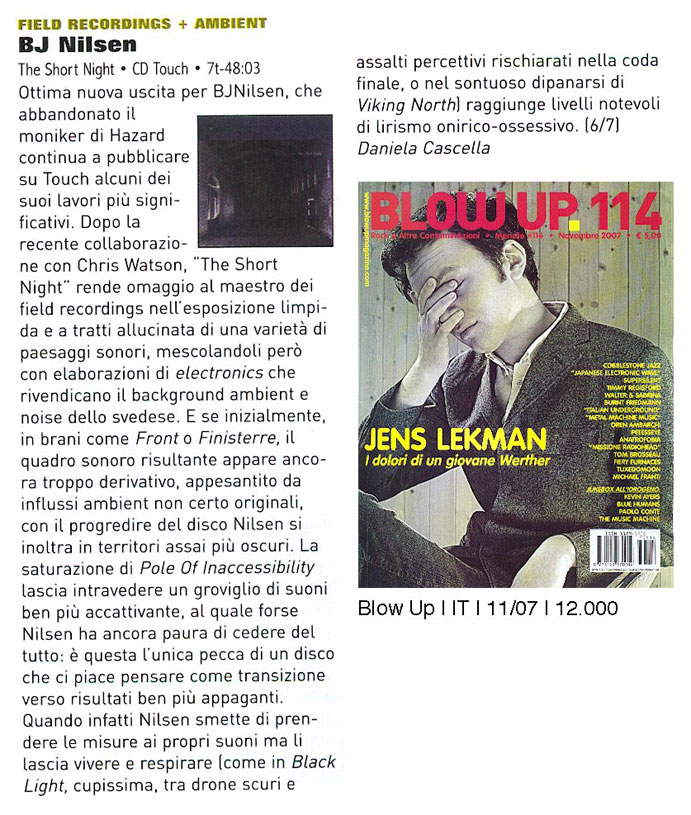
Rockdeluxe (Spain):

GoMag (Spain):
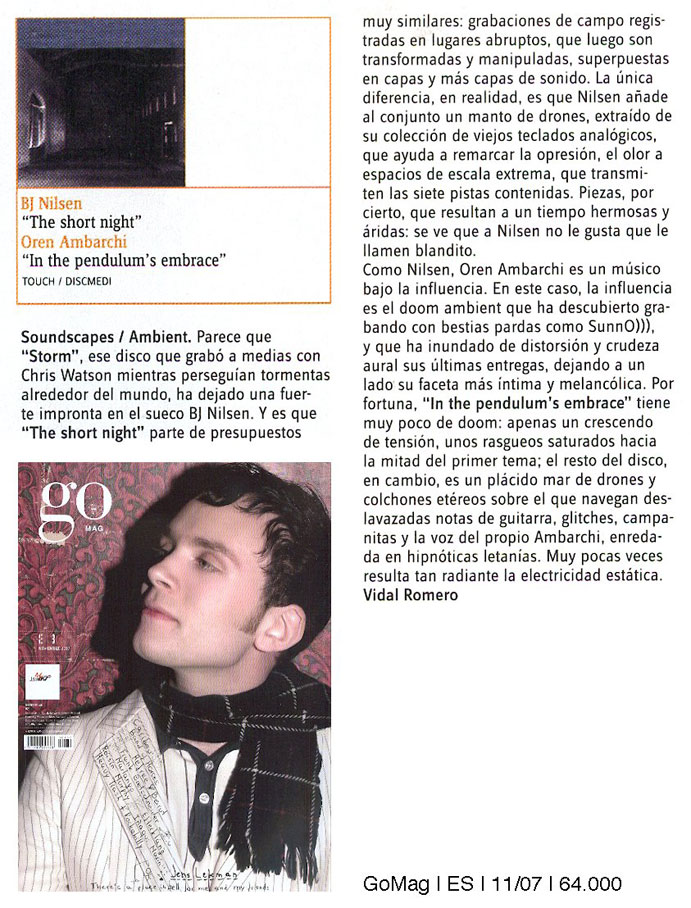
Bad Alchemy (Germany):
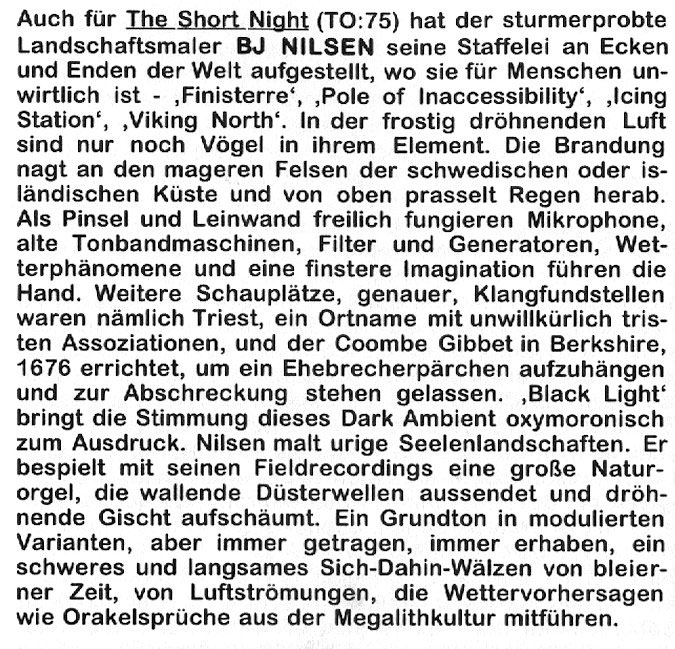
Orkus (Germany):
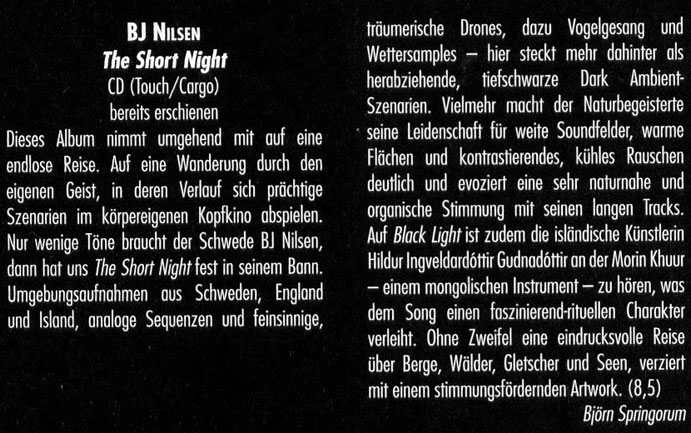
SPEX (Germany):
Geräuschmusik
mit BJ Nilsen, Marcus Schmickler und A_dontigny
Text: Kai Ginkel
Unter dem Pseudonym Hazard wurden vor einigen Jahren zwei Alben herausgegeben, die bis heute zu den famosesten Leistungen im Bereich der Field Recordings gehören: »Wind« und »Land« waren beide so gleichermaßen still und vielsagend, wie man es in diesem Genre, in dem Auswahl und Sorgfalt oftmals über Qualität entscheiden, nur selten zu hören bekommt. Die Kunst, ein schlichtes wie treffsicheres Arrangement auszutüfteln, kombinierte BJ Nilsen, der Mann hinter diesem Projekt, damals mit den ungeheuerlichen Aufnahmetalenten von Chris Watson (u.a. Cabaret Voltaire), der selbst gerade mit einem außergewöhnlichen Album namens »Weather Report” in den Startlöchern stand. Obwohl die beiden ihre Kollaborationen fortsetzen und in Form von »Storm« 2006 sogar vertiefen sollten, bleibt die erhabene Zurückhaltung von »Wind« und »Land« eine Klasse für sich.
Mit »The Short Night« (Touch Music) allerdings ist Nilsen nun ein Longplayer gelungen, den man nach allerlei schönen und gelungenen Zwischenstationen erneut dick hervorheben sollte. Selten zuvor schließlich waren geheimnisvolle Feldaufnahmen so eng und selbstverständlich mit einer musikalischen Begleitung verwachsen, die in dieser Form zur absoluten Speerspitze dessen gehört, was jemals einen Ton auf Touch veröffentlichen durfte. Aus Nilsens Gespür für Stimmungen spricht eine sagenhafte Souveränität: Das sausende Flirren, das sich vermutlich aus der Faszination für die Orgel ergibt, erreicht zuweilen eine derartige Klarheit und Räumlichkeit, dass es fast wie ein Befreiungsschlag aus so viel Anmut erscheint, wenn die Musik in »Pole Of Inaccessibility” plötzlich durchdrungen wird von köstlichen Nebelschwaden aus purer, leidenschaftlicher Verzerrung, die das darauffolgende, betont langwirige Ausschwingen um so eleganter und idyllischer klingen lassen.
Dass »The Short Night« in erster Linie mit analogem Equipment erarbeitet wurde, ist im Grunde genommen nur für unverbesserliche Methodiker von Interesse. Die Idee allerdings schmeichelt Nilsens Musik auch über die bloße Randnotiz hinaus, denn in der Tat klingen diese Tracks in ihrer Qualität sehr griffig und auf überzeugende Weise erdverbunden. Obwohl das Basismaterial im Übrigen nicht nur in Grönland und Island, sondern beispielsweise auch in Triest, Italien, entstanden ist, werden alle sieben Stücke von einem poetischen Sinn für das Kalte getragen, wie man ihn sonst gegenwärtig fast nur bei einem Thomas Köner in vergleichbarer Vollendung erlebt.
KindaMuzik (Netherlands):
Voor zijn vorige album Storm trotseerde Benny Nilsen met een Sennheiser ‘omnidirectional’ microfoon de bulderende wind op de Zweedse kust. Op zijn nieuwe album is de toon een heel stuk serener, al zijn de donkere wolken nog altijd promiment aanwezig in Nilsens muziek. De Zweed is sinds de jaren negentig een vaste waarde in de stal van Touch, het Britse ambientlabel dat kwaliteit boven kwantiteit stelt en onder andere snarenmanipulator Fennesz onder zijn vleugels heeft.
In tegenstelling tot die relatief beroemde Oostenrijker sampelt BJ Nilsen geen gitaren maar de natuur zelf. Voor The Short Night maakte hij veldopnames in Zweden, IJsland en op het Britse platteland. Waar hij af en toe ook aan de radio draaide. Zo duikt halverwege het album ineens een kort en verrassend weerbericht op (‘Viking, Cromarty’).
Nadat zijn analoge vangnet vol zit, verdwijnt de Zweed naar zijn studio om daar met stokoude filters, generatoren en stoffige tapedecks de meest prachtige harmonieën samen te stellen. Al is de toon vaak somber en soms zelfs besmeurd met machineolie. Zoals op het duistere ‘Black Light’, dat klinkt als een fietstocht door het schemerende stille bos naar een geheimzinnige fabriek. Langzaam maar zeker wordt het dreunende geluid van de zware machines sterker. En sterker. Ook langs de kust op ‘Finisterre’ is het niet pluis.
Tegenover zoveel dreiging staat dan weer een prachtig nummer als ‘Pole of Inaccessibility’, waarop je de witbesneeuwde ijsschotsen in gedachte voorbij ziet drijven. Op zo’n moment heeft Nilsen wel wat gemeen met die andere ambientcomponisten uit Scandinavië: Biosphere. The Short Night is verplichte kost voor liefhebbers van het betere zweef- en vliegwerk. Maar neem wel een regenpak mee. [René Passat]
de:bug (Germany):
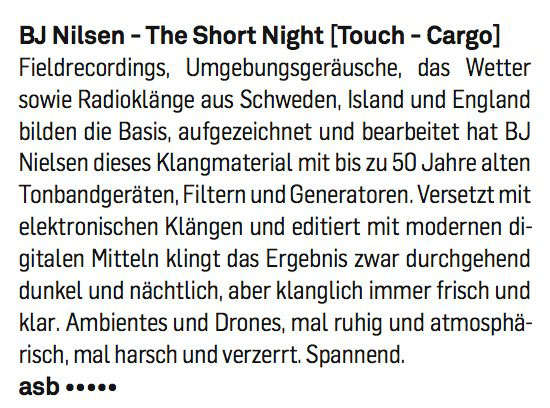
Jazzthetic (Germany):
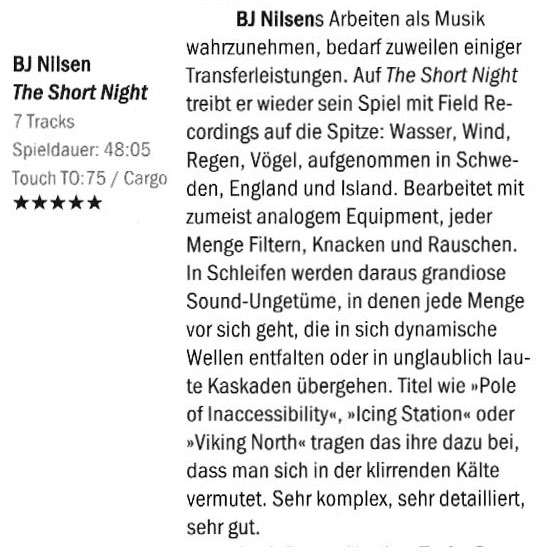
The Wire (UK):

Groove (Sweden):
*Fwomp.* En vindby blåser in en kråka i ett skjul på Islands sydkust. BJ Nilsen har rest runt i Europa och ackumulerat fältinspelningar. Tillbaka i Stockholm låter han dem addera karaktär till den skira ambientmusiken på The Short Night. Det påminner om Brian Enos mer drone-aktiga verk eller den ambienta Biosphere, men ändå med en egen personlighet. Kortare utflykter i mörkare noise-lika territorier gör att lyssnaren inte förlorar intresset. Det är vackert, kanske lite melankoliskt. En skiva som öppnar upp och låter dig resa utan att lämna ditt vardagsrum. [Henrik Strömberg]
Göteborg Posten (Sweden):
The Sound of Music (Sweden):
Med The short night fortsätter svenske BJ Nilsen att spännande utforska gränslandet mellan natur och civilisation. Inspelningar av väder och vind från Sverige, England, Island och Italien sammanförs skickligt med elektroniska utdragna ljud på ett sätt som gör BJ Nilsen till en av de mest intressanta ljudmakarna inom genren. Vackert, filmiskt och storslaget! Engelska väderleksrapporter möter keyboardliknande klanger i låtar med namn som Icing station och Viking north. Och lyckat har musiken i högre grad än tidigare fått strukturer av låtar med melodiska teman, om än långsamma och med en något diffus rytmik. [Magnus Olsson]
Ruis (Belgium):
Geiger (DK):
B(enny) J(onas) Nilsen er anderledes udfordrende i sin udforskning af lyd. Jeg har tidligere prist hans udgivelse med Chris Watson, og Nilsen skuffer heller ikke denne gang.
Nilsen har en formidabel evne til at bruge field recordings, forskelligt optageudstyr og manipulation af elektroniske kilder til at skabe storslåede freskoer af lyd. Han forkaster ikke naturen, men udvider den. Han giver den nærmest kosmiske dimensioner, hvor lytteren suges ind i et nærvær, der bringer én tættere på verden – og det er det mest vidunderlige ved Nilsens musik: at den på én gang skaber distance og nærvær. At den skærper lyttesansen uden brug af traditionelle virkemidler som rytme og melodi. The Short Night bringer endnu en gang lytteren tættere på naturens sublime, uforståelige mysterium.
Octopus (France):
Dans la lignée de Fade to White paru il y a 2 ans, ce nouvel album s’inscrit à la fois dans un prolongement logique par rapport aux travaux récents de Benny Nilsen (dont une magistrale collaboration avec Chris Watson pour l’album Storm publié sur Touch) et également dans une démarche de longue haleine, débutée dans les années 90 sous le nom de Hazard. Maturité oblige, le côté brut d’Hazard a néanmoins été dépassé depuis longtemps, les morceaux de Nilsen étant désormais des compositions à part entière. Si les éléments naturels fournissent toujours la majeure partie du matériel de départ, ces derniers ne sont plus l’unique constituant de l’ensemble et sont régulièrement à l’arrière plan, les nappes issues de vieux synthés analogiques, finement traitées et passées au filtre digital, s’arrogeant une place de choix pour arriver à une synthèse remarquablement équilibrée entre approche environnementale et électronique. Si certains titres gagneraient davantage en densité à être travaillés sur la durée (à l’image de ce “Viking North” et ses 10 minutes d’une rare intensité), ces drones électroniques sombres habillent de leurs vibrations délétères des paysages marins désolés de la manière la plus sûre qui soit. Un brouillard opaque réduit la visibilité au minimum ; si l’onde plane semble calme en surface, nul ne saurait présager ce qui se trame sous ces eaux noires et glacées, transformant ainsi chaque écoute en une errance et une dérive des plus angoissantes. [Aymeric Lozet]
Popnews (France):
Aussi bien connu sous l’appellation Hazard que sous son propre nom, le Suédois BJ Nilsen fait parti avec Mika Vainio, Deathprod et Biosphere pour ne citer que les représentants les plus connus, de cette fameuse école nordique des musiques électroniques. Déjà rien qu’en écrivant cela, on a une petite idée de ce qu’on va écouter : sons analogiques et approche musicale très cérébrale, limite austère. Bien entendu le Suédois ne déroge pas à cette règle mais son nouvel album “The Short Night” apporte une dimension supplémentaire: l’évocation des grands espaces.
Après avoir collaboré avec Chris Watson, l’ex-Cabaret Voltaire devenu le pape du “field recording”, BJ Nilsen s’est converti aux joies de l’enregistrement de terrain et est allé capturer à l’aide d’un appareillage complètement vintage (certains éléments de son équipement étant sortis il y a près de cinquante ans) des sons environnementaux en Suède, en Islande et en Angleterre.
Une fois tous ces sons (oiseaux au loin, murmures de vent, écoulements, diffusions radio) déposés sur le dioxyde de chrome, BJ Nilsen les a intégrés dans des compositions électroniques à la beauté glaciale pour créer une ambient music très personnelle.
Ce qui est saisissant dans ce disque, c’est le travail apporté aux textures, à la granulosité du son, qui donne à ses compositions une profondeur et une puissance étonnante.
Ensuite, il construit sa narration et les sept plages de cet album sont la parfaite bande son d’un voyage nocturne dans les étendues glaciales du grand nord.
Commençant avec des images sonores, évocatrices et apaisantes (“Front”, “Finisterre”), on se laisse prendre par cette nuit remplie d’inconnus, puis la musique va vers une abstraction angoissante, le chromatisme menaçant de “Black Light” nous rappelle alors que ce genre d’aventure nocturne n’est pas sans risque.
Après s’être enfoncé dans une nuit polaire, pour une aventure surnaturelle à la manière de la petite Unn à la recherche “du palais de glace” (“Icing Station”) dans le roman de Tarjei Vesaas, le jour et la civilisation sont de retour avec “Viking North” dans un final aveuglant tout en strates et messages radio.
Rarement une musique aura aussi bien évoqué les espaces qui l’ont inspirée, il n’y a guère que le fameux “Eskimo” des Residents qui, avec une esthétique très différente, arrive aussi bien à retranscrire en sons les sensations et les émotions des grands espaces gelés.
Avec cette harmonie parfaite entre musique électronique et beauté de la nature ce disque trouve parfaitement sa place sur le label Touch grand défenseur d’une approche naturaliste des sons synthétiques, à ranger entre Chris Watson et Rosy Parlane. [Cyril Lacaud]
Solenoide (France):
Arpenteur des grands espaces naturels d’Europe du Nord, BJ Nilsen aime y puiser la matière thématique autant que sonique sur laquelle s’appuient ses différentes productions. Si cette escapade nocturne n’échappe pas à la règle, elle voit désormais le matériau environnemental se mouvoir sur des trames analogiques méticuleusement ouvragées. Magistrale synthèse de manipulations concrètes et de retraitements numériques, cet album brouille un peu plus les lignes démarquant le naturel du surnaturel, l’inquiétant du fascinant.
Gonzo Circus (Belgium):
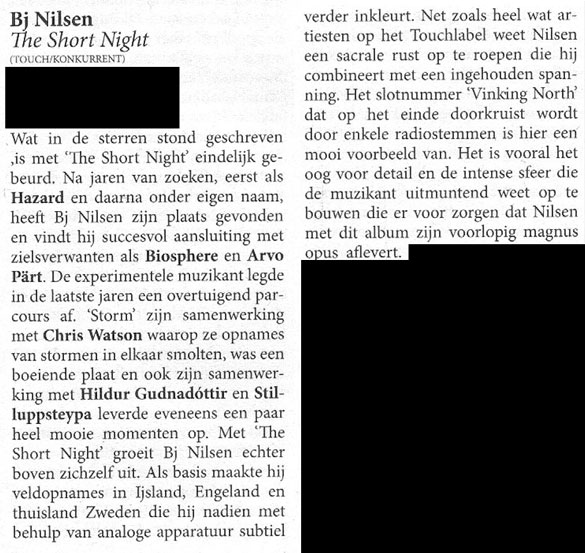
Rockerilla (Italy):
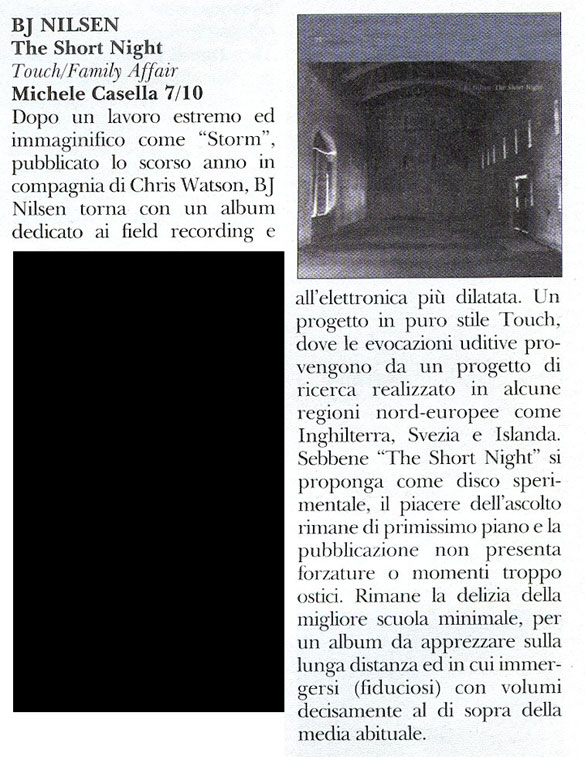
Rock & Pop (Czeckia):

Triggerfish (Germany):
BJ Nilsen, der sich von Morthound über Hazard längst einen Ruf als exzellenter Klangforscher abseits seiner nicht minder erfolgreichen CMI-Vergangenheit erarbeitet hat, legt mit “The Short Night” ein Album vor, das voller mitternächtlicher Sounds steckt.
Vornehmlich sind es wieder Fieldrecordings (diesmal aus Italien, Island, England und Sweden), die als Basismaterial dienen. Diese werden hier innerhalb eines Rahmens platziert, der deutlich über das reine Collagieren der Aufnahmen hinausgeht. Für die sechs Tracks des Albums arbeitet Nilsen verstärkt mit musikalischen Elementen, die nahtlos eine Verbindung mit dem nichtmusikalischen Material eingehen. Hierbei entstehen akustische Stimmungsbilder aus tiefster Nacht, Gefühle von Übermüdung und stundenlangen Fahrten auf stockdunklen Landstraßen. Ambiente Musik für schlaflose Nächte bei sternenklaren Himmel.
Vinylfans mit etwas Geduld dürfen sich übrigens freuen: Neben der CD auf Touch ist eine Vinylversion auf Autofact in Planung, deren Erscheinungsdatum aber noch nicht festzustehen scheint. 5/6 [Sascha Bertoncin]
Touching Extremes (France):
There are records that ensure instant gratification to the senses and “The short night” happens to belong to that area. Sound artist BJ Nilsen found a way to organize and deploy his materials with a methodological rationality which nevertheless hides large quantities of aural pleasure. He mixed in fact field recordings from Sweden, England, Italy and Iceland with quietly unfolding electronic backgrounds – at times reminiscent of the best Eno – and harsher manifestations of saturated, oppressive static music, the whole obtained through an array of machines (minutely detailed by the author on the cover) of prevalently analogue derivation, yielding sonorities whose embracing, but at the same time dangerous warmth is at the basis of several moments of sluggish torpor. The distant voices perceived amidst the underlying drone at the beginning of “Finisterre” let us think to the cross of marine rumble and human presence typical of our childhood’s days at the seaside, but it’s soon taken apart by an outgrowth of semi-distorted pale resonance, while “Viking, CromartyŠ” is based on one of the most emotion-eliciting mumbles heard lately, upon which granular movements of uncertain origin build repetitive patterns and oscillations until we reach Rapoon-ish lands, then everything gets mangled by acrid discharges of electricity. There’s actually nothing here that I didn’t hear before in a form or another, yet Nilsen seems to have a knack for nailing the exact moment in which depth and charm should be exchanged, thus erasing the predictability factor from his creations. [Massimo Ricci]
Gonzo Circus (Belgium):
Wat in de sterren stond geschreven ,is met ‘The Short Night’ eindelijk gebeurd. Na jaren van zoeken, eerst als Hazard en daarna onder eigen naam, heeft BJNilsen zijn plaats gevonden en vindt hij succesvol aansluiting met zielsverwanten als Biosphere en Arvo Pärt. De experimentele muzikant legde in de laatste jaren een overtuigend parcours af. ‘Storm’ zijn samenwerking met Chris Watson waarop ze opnames van stormen in elkaar smolten, was een boeiende plaat en ook zijn samenwerking met Hildur Gudnadóttir en Stilluppsteypa leverde eveneens een paar heel mooie momenten op. Met ‘The Short Night’ groeit BJNilsen echter boven zichzelf uit. Als basis maakte hij veldopnames in Ijsland, Engeland en thuisland Zweden die hij nadien met behulp van analoge apparatuur subtiel verder inkleurt. Net zoals heel wat artiesten op het Touchlabel weet Nilsen een sacrale rust op te roepen die hij combineert met een ingehouden spanning. Het slotnummer ‘Vinking North’ dat op het einde doorkruist wordt door enkele radiostemmen is hier een mooi voorbeeld van. Het is vooral het oog voor detail en de intense sfeer die de muzikant uitmuntend weet op te bouwen die er voor zorgen dat Nilsen met dit album zijn voorlopig magnus opus aflevert. [PDS]
losingtoday.com (Italy):
BJNilsen registra suoni della natura passeggiando per terre scandinave e poi li manipola nel suo studio ToneRoom di Stoccolma utilizzando strumenti elettronici allo stato dell’arte. Punto forte della sua strumentazione è un’invidiabile collezione di microfoni che gli permettono di fissare nel tempo ogni minima variazione di pressione causata da una goccia d’acqua, un granello di terra o una nuvola. “The Short Night” è il quarto album che la Touch pubblica di BJNilsen. Già di per se una garanzia per quanti seguono con passione le vicende della gloriosa etichetta inglese. Altri lavori del musicista svedese sono stati pubblicati dalla Helen Scarsdale Agency di Jim Haynes. “The Short Night” è anche il miglior disco fino ad oggi realizzato da Nilsen. L’opera si apre con i quindici minuti di apparente serenità di “Front”, dove le macchine di Nilsen lavorano silenziosamente per lasciare i suoni della natura più incontaminati possibile. Al contrario sulla seguente “Finisterre” la mano di Bj si fa sentire andando a definire un piccolo capolavoro elettroacustico, tra il permefrost di Thomas Köner e il vento polare di Biosphere. [Roberto Mandolini]










